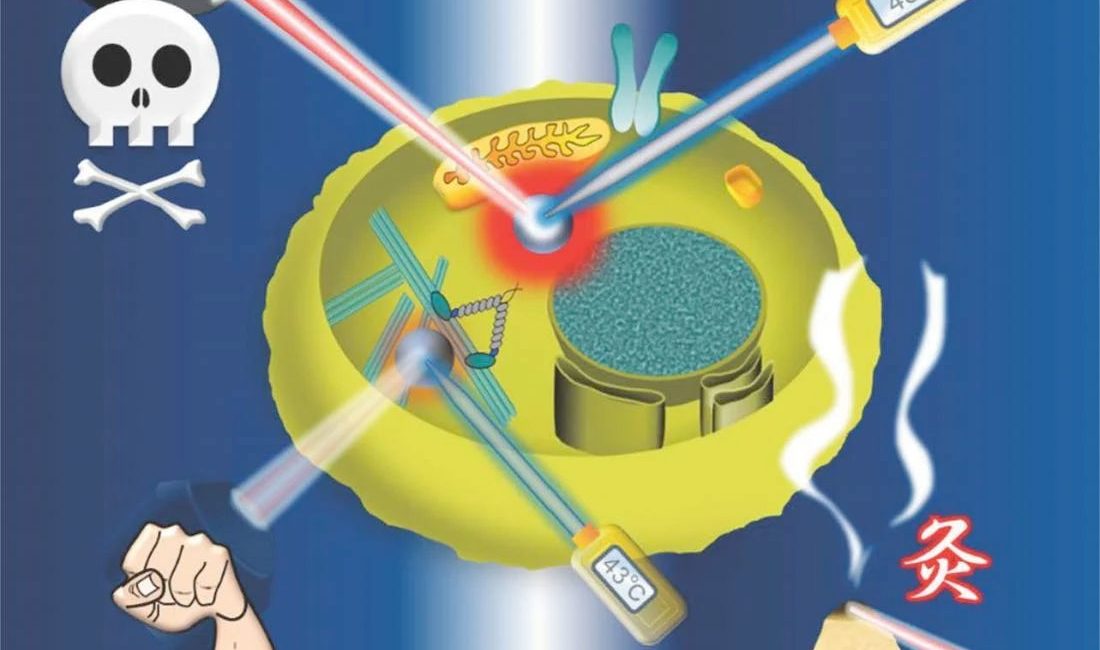| Aug 10, 2022 |
|
(Nanowerk News) Researchers at Kanazawa University report in ACS Nano (“Modulation of Local Cellular Activities using a Photothermal Dye-Based Subcellular-Sized Heat Spot”) the development of a nanoparticle that acts as a heater and a thermometer. Inserting the nanoparticle in living cells results in a heat spot that, by switching it on and off, enables the controlled modulation of local cellular activities.
|
 |
| Figure 1. Thermodynamic Cell Engineering: Creating a tiny heat spot enables to regulate cellular functions. (Image: Kanazawa University)
|
|
Being able to heat nano-sized regions in biological tissues is key to several biomedical applications. Indeed, many biological processes are temperature-sensitive, and the ability to locally modify temperature provides a way to manipulate cellular activity. A notable purpose is the destruction of cancer cells by heating them. Beside the need for an in-tissue local heating mechanism, it also important to be able to instantaneously measure the generated temperature.
|
|
Satoshi Arai from Kanazawa University and colleagues have now engineered a nanoparticle that is both a nanoheater and a nanothermometer at the same time. They successfully showed that the insertion of a single, controllable heat spot in tissue can be very effective in modifying cellular function.
|
|
The nanoparticle, called “nanoHT” by the scientists — an abbreviation of “nanoheater-thermometer” — is essentially a polymer matrix embedding a dye molecule (called EuDT) used for sensing temperature, and another dye molecule (called V-Nc) for releasing heat. The latter happens through the conversion of light into thermal energy (the photothermal effect, also exploited in solar cells): shining a near-infrared laser (with a wavelength of 808 nanometer) onto V-Nc results in fast heating, with a stronger increase in temperature for higher laser power.
|
|
Temperature sensing is based on the thermal fluorescence effect of EuDT. When irradiated with light of one wavelength, the molecule emits light at another wavelength — fluorescence. The higher the temperature, the less intense the fluorescence becomes. This inverse relationship can be used to measure temperature. Arai and colleagues tested the performance of nanoHT as a thermometer, and established that it can determine temperatures with a resolution of 0.8 °C and less.
|
 |
| Figure 2. Microscopic system for nanoheating. A) Schematic and microscopic images of nanoheater (nanoHT) (Transmission electron microscopy). B) A system to warm up a localized region at single cellular level (upper panel). A single dot of nanoHT was located within a single cell (lower left panel). Temperature gradient at microscale was generated at subcellular level (lower right panel). (Image: Kanazawa University)
|
|
The researchers then performed experiments with a type of human cells called HeLa cells. They looked at the effect of heating through nanoHT, and found that at a temperature increment of about 11.4 °C, the heated HeLa cells died after only a few seconds. This finding suggests that nanoHT could be used to induce cell death in cancer cells.
|
|
Arai and colleagues also studied how nanoHT can be used to affect the behavior of muscles. They introduced the nanoparticle into myotube, a type of fiber present in muscle tissue. Upon heating the myotube by approximately 10.5 °C, the muscle tissue contracted. The procedure worked reversibly; letting the myotube cool again led to muscle relaxation.
|
|
The work of Arai and colleagues shows that local heating at a subcellular scale by means of nanoHT enables the controlled manipulation of a single cell’s activity. Regarding applications, the scientists believe that “the targeted application of nanoHT has a diverse and versatile range of capabilities to regulate cellular activities that would facilitate the development of thermodynamic cell engineering.”
|
 |
| Figure 3. A nanoparticle combining photothermal heating and fluorescence thermometry functions as a localized heat spot, and is capable of inducing cell death or muscle contraction. (Image: Kanazawa University)
|
Background: Fluorescence
|
|
Fluorescence refers to the emission of light by a substance after which it has absorbed light (or another type of electromagnetic radiation). Typically, the emitted light has a longer wavelength, and so a lower photon energy, than the absorbed radiation. A well-known case of fluorescence happens when the absorbed radiation is in the ultraviolet region of the spectrum, invisible to the human eye, while the emitted light is in the visible region.
|
|
Fluorescent thermometry is a technique for measuring temperatures through the use of fluorescent dye molecules, the fluorescence intensity of which is a strong function of temperature. The dye molecules are inserted into a material of interest; detailed knowledge of the fluorescence intensity vs. temperature dependence enables to infer the temperature of the material. (The dye molecules are excited to fluoresce by incident light; its intensity provides a measure of the local temperature.)
|
|
Satoshi Arai from Kanazawa University and colleagues used fluorescence dye molecules to develop nanoHT, a nanoparticle acting as both a heater and a thermometer for nano-bio applications.
|




